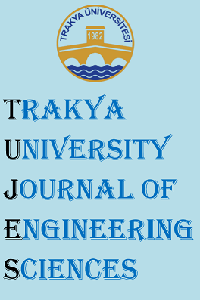COOLING LOAD REDUCTION WITH TRANSPIRED SOLAR COLLECTORS
When considering energy reduction issues of the building sector, one cannot overlook the importance of cooling load reduction. Depending on a country’s primary energy conversion factor, producing one unit of cooling energy with a chiller can require three times as much primary energy, than producing one unit of heating energy with a boiler. A remarkable amount of the cooling load of a building reaches the interior through the roof, as roofs can be as hot as 70 °C under strong solar radiation. Roof ventilation with double-layer structures offers a reliable temperature reduction between the solar exposed upper layer and the lower one, which is the actual building roof. The transpired solar collector (TSC) is a proven technology for solar air heating with numerous installed and successfully operated systems around the world. This paper reflects on its passive cooling potential, when the perforated metal plate absorber is installed on a building’s roof. At night, the perforated plate acts as a radiating shield, which loses heat towards the cold sky. Thus, after the perforated plate has cooled below ambient temperature, outdoor air can be cooled, which is later used for nocturnal ventilation of the building. However, the predicted cooling energy during an analysis of the radiant cooling strongly depends on the sky temperature model chosen. Different models of sky temperature are compered in their result on the longwave radiant heat flux towards the sky. The comparison is carried out for four cities with different climate. Results reflect on a novel application of the transpired solar collector, which therefore can be used for the reduction of building energy consumption over the entire year.
Anahtar Kelimeler:
Transpired solar collector, Roof ventilation, Nocturnal radiation, Passive cooling, Solar cooling load reduction
___
- Referans 1 Al-Obaidi KM, Ismail M, Abdul Rahman AM, (2014), Design and performance of a novel innovative roofing system for tropical landed houses. Energy Conversion and Management, 85 pp. 488-504.
- Referans 2 Artmann N, Manz H, Heiselberg P, (2007), Climatic Potential for Passive Cooling of Buildings by Night-time Ventilation in Europe. Applied Energy, 84 187-201
- Referans 3 Artmann N, Manz H, Heiselberg P, (2008), Parameter Study on Performance of Building Cooling by Night-time Ventilation. Renewable Energy, 33 2589-2598
- Referans 4 Berdahl P, Fromberg R, (1982), The thermal radiance of clear skies. Solar Energy, 29 299-314.
- Referans 5 Berger X, Buriot D, Garnier F, (1984), About the equivalent radiative temperature for clear skies, DOI:10.1016/0038-092X(84)90247-0
- Referans 6 Bliss RA, (1961), Atmospheric radiation near the surface of the ground. Solar Energy, 5 103.
- Referans 7 P., Spérandio M., Allard F., (1997), Night Ventilation for Building Cooling in Summer. Solar Energy Vol. 61. No. 5. pp. 327-335.
- Referans 8 Bokor B, Akhan H, Eryener D, Kajtár L., (2017), Theoretical and experimental analysis on the passive cooling effect of transpired solar collectors. Energy and Buildings 156 pp. 109-120.
- Referans 9 Ciampi M., Leccese F., Tuoni G., (2005), Energy analysis of ventilated and microventilated roofs. Solar Energy, 79 pp 183-192.
- Referans 10 Clark G, (1981), Passive/Hybrid comfort cooling by thermal radiation. Passive/Hybrid Cooling Conference, Miami.
- Referans 11 Duffie JA, Beckman WA, (2013), Solar Engineering of Thermal Processes. 4th edition. John Wiley & Sons. New Jersey.
- Referans 12 Hall R, Blower J., (2016), Low emissivity transpired solar collectors. Energy Procedia, 91 56-63.
- Referans 13 Hall R, Wang X, Ogden R, Elghali L., (2011), Transpired Solar Collectors for Ventilation Air Heating – Proceedings of the Institution of Civil Engineers pp 101-110.
- Referans 14 Hartfield JL, Reginato RJ, Idso SB, (1983), Comparison of long-wave radiation calculation methods over the United States. Water Resour Res., 19,285.
- Referans 15 Hollick J., (2012), Nocturnal radiation cooling tests. Energy Procedia, 30 930-936.
- Referans 16 Kolokotroni M, Aronis A., (1999), Cooling-energy Reduction in Air-conditioned Offices by Using Night Ventilation. Applied Energy, 63 241-253
- Referans 17 Kolokotroni M, Webb BC, Hayes D., (1998), Summer Cooling with Night Ventilation for Office Buildings in Moderate Climates. Energy and Buildings, 27 231-237
- Referans 18 Kumar S, Leon MA., (2007), Mathematical Modeling and Thermal Performance Analysis of Unglazed Transpired Solar Collectors. Solar Energy, 81 62-75.
- Referans 19 Kutscher CF, Christensen CB, Barker GM., (1993), Unglazed Transpired Solar Collectors: Heat Loss Theory. Journal of Solar Energy Engineering, Vol. 115, August, pp. 182-188.
- Referans 20 Puangsombut W, Hirunlabh J, Khedari J, Zeghmati B, Win MM., (2007), Enhancement of natural ventilation rate and attic heat gain reduction of roof solar collector using radiant barrier. Building and Environment 42 pp. 2218-2226.
- Referans 21 RETScreen International, (1997-2005), Clean Energy Decision Support Centre: RETScreen Software Online User Manual, Solar Air Heating Project Model. Ministry of Natural Resources, Canada, ISBN: 0-662-39636-7
- Referans 22 Roslan Q, Ibrahim SH, Affandi R, Nawi MNM, Baharun A., (2016), A literature review on the improvement strategies of passive design for the roofing system of the modern house in a hot and humid climate region. Frontiers of Architectural Research, 5 pp 126-133.
- Referans 24 Swinbank WC., (1963), Long-wave radiation from clear skies. Q J R Meteorol Soc., 89 339-348.
- Referans 25 Vall S, Castell A., (2017), Radiative cooling as low-grade energy source: A literature review. Renewable and Sustainable Energy Reviews, 77 803-820.
- Referans 26 http://sahwia.org/ (Last downloaded: 8/02/2018)
- Referans 27 https://www.weatherbase.com/weather/weather.php3?s=19216&cityname=Bamako-Mali
- Referans 28 https://www.weatherbase.com/weather/weather.php3?s=605816&cityname=Tunis-Tunisia
- Referans 29 https://www.weatherbase.com/weather/weather.php3?s=66061&cityname=Milan-Italy
- Referans 30 https://www.weatherbase.com/weather/weather.php3?s=74101&cityname=Hamburg-Germany
- ISSN: 2147-0308
- Yayın Aralığı: Yılda 2 Sayı
- Başlangıç: 2000
- Yayıncı: Trakya Üniversitesi
